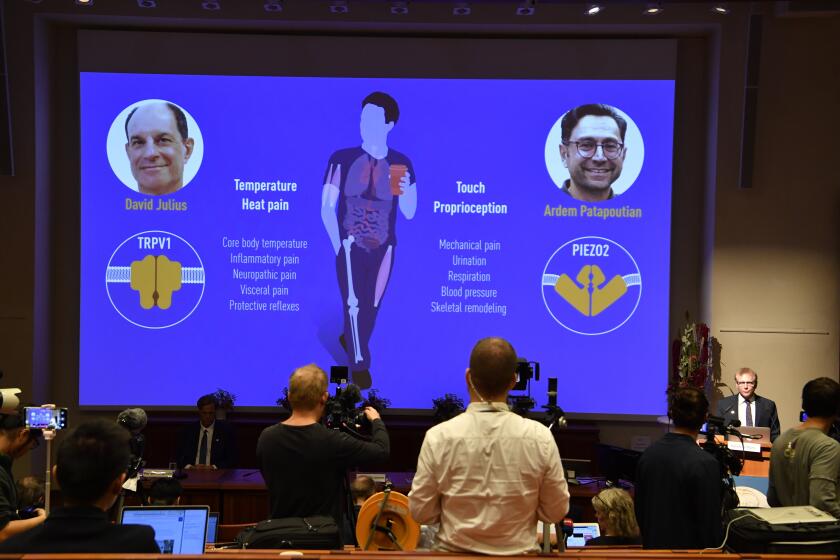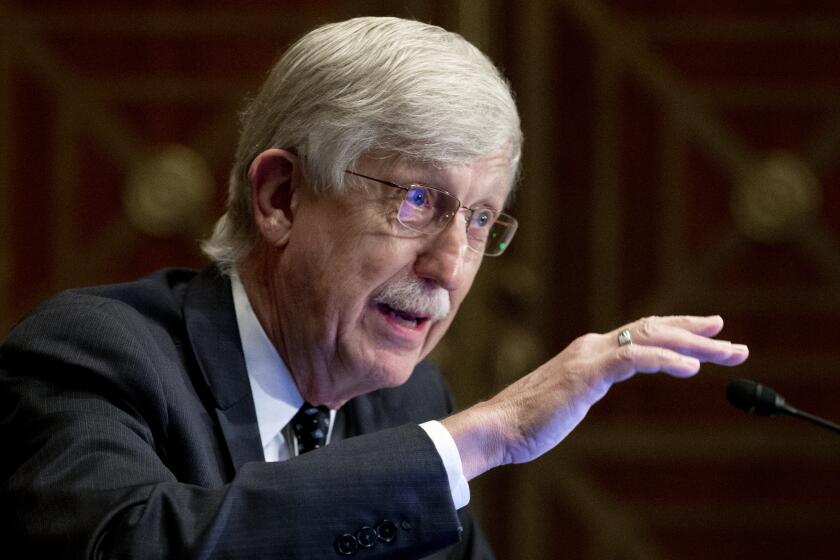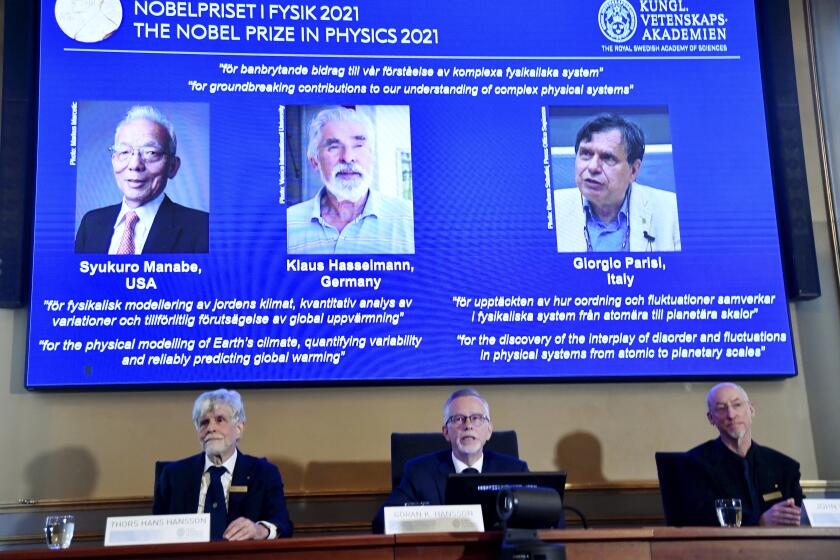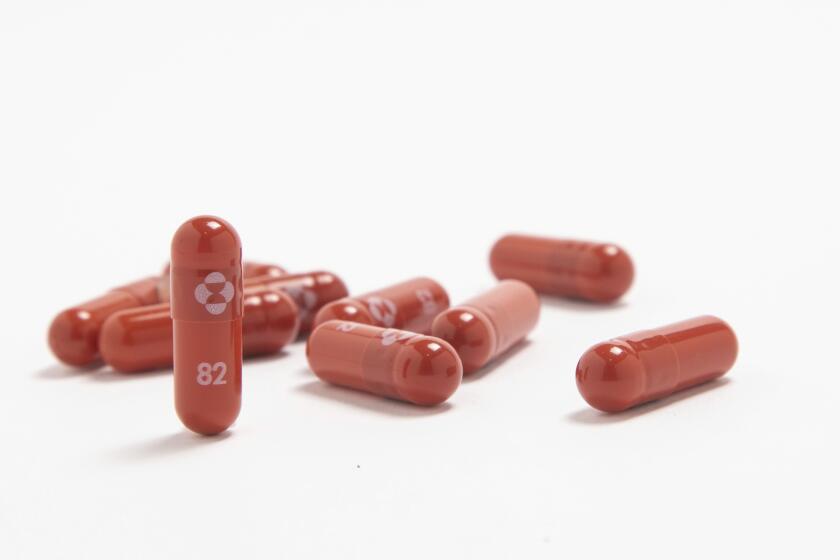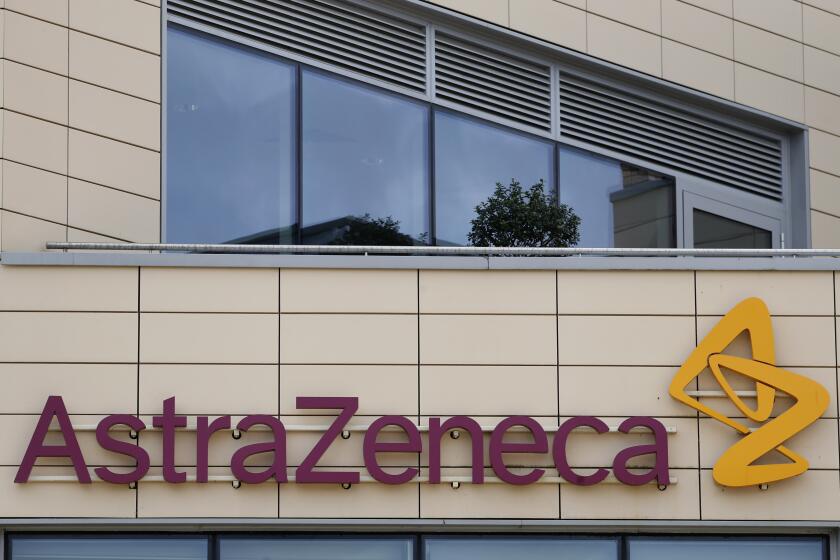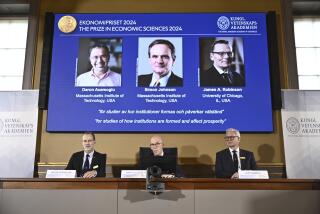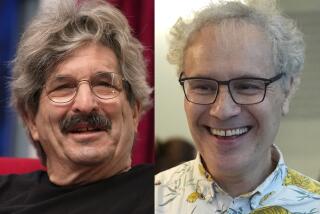Winners of chemistry Nobel honored for their efficient new way of making molecules
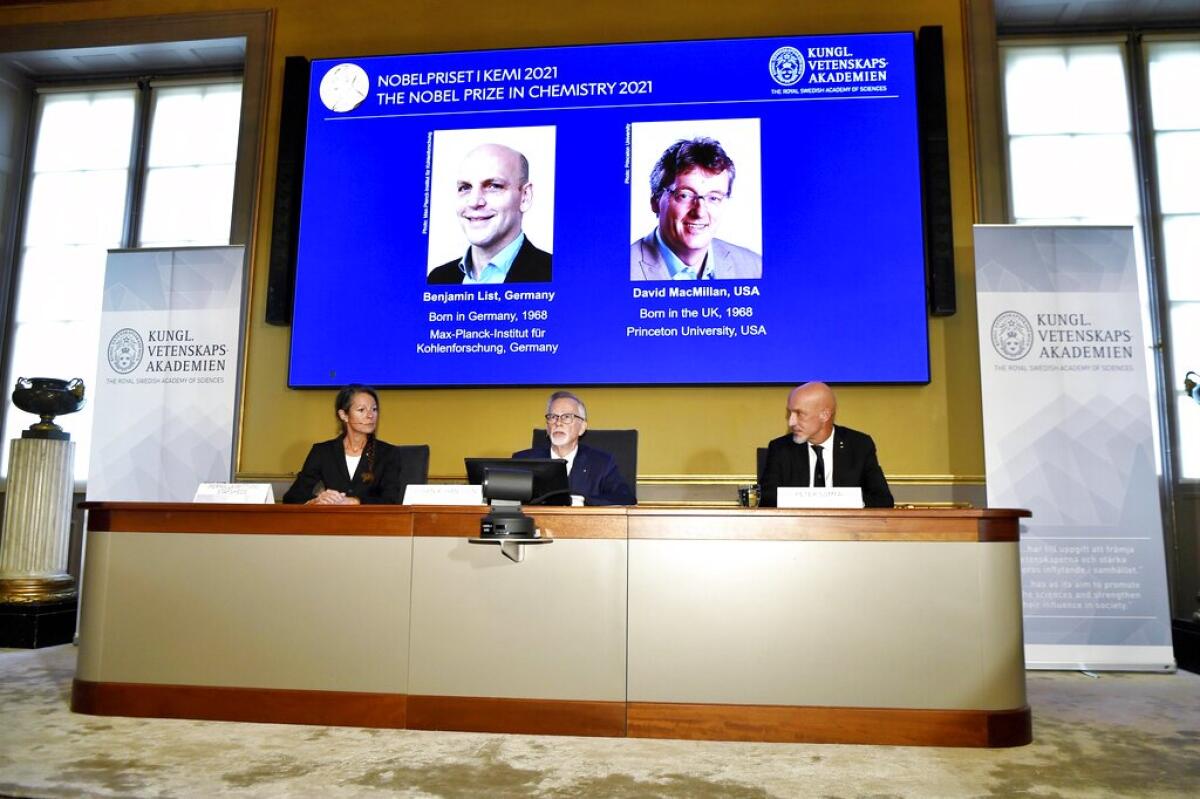
- Share via
STOCKHOLM — Two scientists won the Nobel Prize for chemistry Wednesday for finding an “ingenious” and environmentally cleaner way to build molecules — an approach now used to make a variety of compounds, including medicines and pesticides.
The work of Benjamin List and David W.C. MacMillan has allowed scientists to produce those molecules more cheaply, efficiently, safely and with significantly less hazardous waste.
“It’s already benefiting humankind greatly,” said Pernilla Wittung-Stafshede, a member of the Nobel panel. She called it a “truly elegant tool.”
It was the second day in a row that a Nobel Prize went to work that had environmental implications. The physics prize Tuesday honored developments that expanded our understanding of climate change, just weeks before the start of global climate talks in Scotland.
The chemistry prize focused on the business of making molecules. That requires linking individual atoms together in a specific arrangement — a difficult and slow task. Until the beginning of the millennium, chemists had only two methods, or catalysts, to speed up the process, using either complicated enzymes or metal catalysts.
That all changed in 2000 when List, who works at the Max Planck Institute in Germany, and MacMillan, who teaches at Princeton University, independently reported that small organic molecules can be used to do the same job. The new tools have been important for developing medicines and minimizing drug manufacturing glitches, including problems that can cause harmful side effects.
Two California scientists win the Nobel Prize in medicine for their groundbreaking work on the sense of touch and temperature.
Johan Aqvist, chair of the Nobel Committee for Chemistry, called the method as “simple as it is ingenious,” adding that “many people have wondered why we didn’t think of it earlier.”
MacMillan said that winning the prize left him “stunned, shocked, happy, very proud.”
“I grew up in Scotland, a working-class kid. My dad’s a steelworker. My mom was a home help…. I was lucky enough to get a chance to come to America, to do my PhD,” he said.
In fact, he said at a news conference in Princeton, he was planning to follow his older brother into physics, but the physics classes in college were at 8 a.m. in a cold and leaky classroom in rainy Scotland, while the chemistry courses were two hours later in warmer, drier spaces. As he told that story, he said he could hear his wife pleading with him not to share it.
His said the inspiration for his Nobel-winning work came when thinking about the dirty process of making chemicals — one that requires precautions he likened to those taken at nuclear power plants.
If he could devise a way of making medicines faster by completely different means that didn’t require vats of metal catalysts, the process would be safer for both workers and the planet, he reasoned.
List said he did not initially know MacMillan was working on the same subject and figured his own hunch might just be a “stupid idea” — until it worked. At that eureka moment, “I did feel that this could be something big,” the 53-year-old said.
The National Institutes of Health’s work on coronavirus tests and vaccines has reached ‘a pretty stable place,’ says departing Dr. Francis Collins.
H.N. Cheng, president of the American Chemical Society, said the Nobel laureates had developed “new magic wands.”
Before their work, “the standard catalysts frequently used were metals, which frequently have environmental downsides,” said Cheng. “They accumulate, they leach, they may be hazardous.”
The catalysts that MacMillan and List pioneered “are organic, so they will degrade faster, and they are also cheaper,” Cheng said.
The Nobel Prize in physics has been awarded to three scientists for their work on understanding the climate and on disorder in complex systems.
The Nobel panel noted that their contributions made the production of key drugs easier, including an antiviral and an anti-anxiety medication.
“One way to look at their work is like molecular carpentry,” said John Lorsch, director of the National Institute of General Medical Sciences at the U.S. National Institutes of Health.
“They’ve found ways to not only speed up the chemical joining,” he said, “but to make sure it only goes in either the right-handed or left-handed direction.”
The ability to control the orientation in which new atoms are added to molecules is important. Failing to do so can result in side effects in drugs, the Nobel panel explained, citing the catastrophic example of thalidomide, which caused severe birth defects in children.
Since the scientists’ discovery, the tool has been further refined, making it many times more efficient.
Peter Somfai, another member of the committee, stressed the importance of the discovery for the world economy.
“It has been estimated that catalysis is responsible for about 35% of the world’s GDP, which is a pretty impressive figure,” he said. “If we have a more environmentally friendly alternative, it’s expected that that will make a difference.”
List was born in Frankfurt, Germany, and made many of his discoveries while at the Scripps Research Institute in La Jolla. MacMillan received his doctorate at UC Irvine and did much of his groundbreaking research at UC Berkeley.
Drugmaker Merck says its experimental COVID-19 pill reduced hospitalizations and deaths by half in people recently infected with the coronavirus.
The NIH supported List’s research with a grant in 2002. MacMillan’s work has received funding from NIH since 2000, for a total of around $14.5 million to date.
“It’s a great example of supporting basic science that you don’t necessarily know where it’s going to go” but can have major impact, said Francis Collins, NIH director.
Breaking News
Get breaking news, investigations, analysis and more signature journalism from the Los Angeles Times in your inbox.
You may occasionally receive promotional content from the Los Angeles Times.
List said the award would allow him even greater freedom in his future work.
“I hope I live up … to this recognition and continue discovering amazing things,” he said.
It is common for several scientists who work in related fields to share the prize. Last year, the prize went to Emmanuelle Charpentier of France and Jennifer A. Doudna of the United States for developing a gene-editing tool that has revolutionized science by providing a way to alter DNA.
AstraZeneca has asked the Food and Drug Administration to authorize the emergency use of an antibody treatment to prevent COVID-19.
The award comes with a gold medal and 10 million Swedish kronor (more than $1.14 million). The prize money comes from a bequest left by the prize’s creator, Swedish inventor Alfred Nobel, who died in 1895.
On Monday, the Nobel Committee awarded the prize in physiology or medicine to Americans David Julius and Ardem Patapoutian for their discoveries into how the human body perceives temperature and touch.
The Nobel Prize in physics was awarded Tuesday to three scientists whose work found order in seeming disorder, helping to explain and predict complex forces of nature, including climate change.
Over the coming days prizes will also be awarded in the fields of literature, peace and economics.
